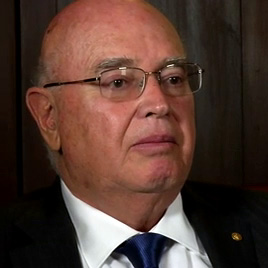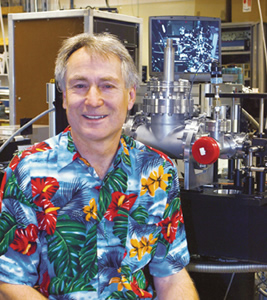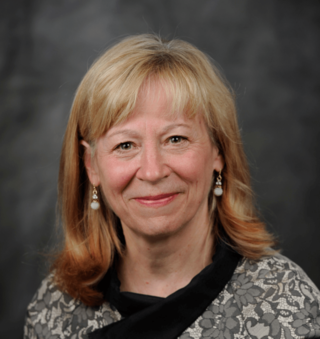Related Research Articles
Surface science is the study of physical and chemical phenomena that occur at the interface of two phases, including solid–liquid interfaces, solid–gas interfaces, solid–vacuum interfaces, and liquid–gas interfaces. It includes the fields of surface chemistry and surface physics. Some related practical applications are classed as surface engineering. The science encompasses concepts such as heterogeneous catalysis, semiconductor device fabrication, fuel cells, self-assembled monolayers, and adhesives. Surface science is closely related to interface and colloid science. Interfacial chemistry and physics are common subjects for both. The methods are different. In addition, interface and colloid science studies macroscopic phenomena that occur in heterogeneous systems due to peculiarities of interfaces.

Raman spectroscopy is a spectroscopic technique typically used to determine vibrational modes of molecules, although rotational and other low-frequency modes of systems may also be observed. Raman spectroscopy is commonly used in chemistry to provide a structural fingerprint by which molecules can be identified.

Molecular engineering is an emerging field of study concerned with the design and testing of molecular properties, behavior and interactions in order to assemble better materials, systems, and processes for specific functions. This approach, in which observable properties of a macroscopic system are influenced by direct alteration of a molecular structure, falls into the broader category of “bottom-up” design.

Gabor A. Somorjai is a professor of chemistry at the University of California, Berkeley, and is a leading researcher in the field of surface chemistry and catalysis, especially the catalytic effects of metal surfaces on gas-phase reactions. For his contributions to the field, Somorjai won the Wolf Prize in Chemistry in 1998, the Linus Pauling Award in 2000, the National Medal of Science in 2002, the Priestley Medal in 2008, the 2010 BBVA Foundation Frontiers of Knowledge Award in Basic Science and the NAS Award in Chemical Sciences in 2013. In April 2015, Somorjai was awarded the American Chemical Society's William H. Nichols Medal.
Giacinto Scoles is a European and North American chemist and physicist who is best known for his pioneering development of molecular beam methods for the study of weak van der Waals forces between atoms, molecules, and surfaces. He developed the cryogenic bolometer as a universal detector of atomic and molecule beams that not only can detect a small flux of molecules, but also responds to the internal energy of the molecules. This is the basis for the optothermal spectroscopy technique which Scoles and others have used to obtain very high signal-to noise and high resolution ro-vibrational spectra.
Robert Graham Cooks is the Henry Bohn Hass Distinguished Professor of Chemistry in the Aston Laboratories for Mass Spectrometry at Purdue University. He is an ISI Highly Cited Chemist, with over 1,000 publications and an H-index of 144.

Richard James Saykally is an American chemist. He is currently the Class of 1932 Endowed Professor of Chemistry at the University of California, Berkeley. He has received numerous awards for his research on the molecular characteristics of water and aqueous solutions.
Sum frequency generation spectroscopy (SFG) is a nonlinear laser spectroscopy technique used to analyze surfaces and interfaces. It can be expressed as a sum of a series of Lorentz oscillators. In a typical SFG setup, two laser beams mix at an interface and generate an output beam with a frequency equal to the sum of the two input frequencies, traveling in a direction allegedly given by the sum of the incident beams' wavevectors. The technique was developed in 1987 by Yuen-Ron Shen and his students as an extension of second harmonic generation spectroscopy and rapidly applied to deduce the composition, orientation distributions, and structural information of molecules at gas–solid, gas–liquid and liquid–solid interfaces. Soon after its invention, Philippe Guyot-Sionnest extended the technique to obtain the first measurements of electronic and vibrational dynamics at surfaces. SFG has advantages in its ability to be monolayer surface sensitive, ability to be performed in situ, and its capability to provide ultrafast time resolution. SFG gives information complementary to infrared and Raman spectroscopy.
Veronica Vaida is a Romanian-American chemist and professor at the University of Colorado Boulder. She is an expert in environmental chemistry and aerosols.

Geraldine Lee Richmond is an American chemist and physical chemist who is serving as the Under Secretary of Energy for Science in the US Department of Energy. Richmond was confirmed to her DOE role by the United States Senate on November 5, 2021. Richmond is the Presidential Chair in Science and professor of chemistry at the University of Oregon (UO). She conducts fundamental research to understand the chemistry and physics of complex surfaces and interfaces. These understandings are most relevant to energy production, atmospheric chemistry and remediation of the environment. Throughout her career she has worked to increase the number and success of women scientists in the U.S. and in many developing countries in Africa, Asia and South America. Richmond has served as president of the American Association for the Advancement of Science, and she received the 2013 National Medal of Science.
Dominique Langevin is a French researcher in physical chemistry. She is research director at the Centre national de la recherche scientifique and leads the liquid interface group in the Laboratory of Solid State Physics at the University of Paris-Sud. She was the Life and Physical Sciences Panel chair for the European Space Sciences Committee of the European Science Foundation from 2013-2021.
Barbara J. Finlayson-Pitts is a Canadian-American atmospheric chemist. She is a professor in the chemistry department at the University of California, Irvine and is the Director of AirUCI Institute. Finlayson-Pitts and James N. Pitts, Jr. are the authors of Chemistry of the Upper and Lower Atmosphere: Theory, Experiments, and Applications (1999). She has been a member of the National Academy of Sciences since 2006 and is the laureate for the 2017 Garvan–Olin Medal. In 2016 she co-chaired the National Academy of Science report "The Future of Atmospheric Chemistry Research"
Hind Al-Abadleh is a professor of chemistry at Wilfrid Laurier University in Waterloo, Ontario, Canada. She studies the physical chemistry of environmental interfaces, aerosols and climate change.
Kimberly A. Prather is an American atmospheric chemist. She is a distinguished chair in atmospheric chemistry and a distinguished professor at the Scripps Institution of Oceanography and department of chemistry and biochemistry at UC San Diego. Her work focuses on how humans are influencing the atmosphere and climate. In 2019, she was elected a member of the National Academy of Engineering for technologies that transformed understanding of aerosols and their impacts on air quality, climate, and human health. In 2020, she was elected as a member of the National Academy of Sciences. She is also an elected Fellow of the American Philosophical Society, American Geophysical Union, the American Association for the Advancement of Science, American Philosophical Society, and the American Academy of Arts and Sciences.
Wang Hongfei is a physical chemist and chemical physicist. Since 2017, he is a professor in the department of chemistry of Fudan University in Shanghai, China.
Paul Fenter is a senior physicist and leader for Interfacial Processes Group, in the Chemical Sciences and Engineering Division at the U.S. Department of Energy’s (DOE) Argonne National Laboratory and the former director of the Center for Electrochemical Energy Science (CEES), a DOE Energy Frontier Research Center.

Sylvie Roke is a Dutch chemist and physicist specialized in photonics and aqueous systems. As a full professor she holds Julia Jacobi Chair of Photomedicine at EPFL and is the director of the Laboratory for fundamental BioPhotonics.

Mary Jane Shultz is an American professor and researcher in physical, environmental, materials and surface chemistry at Tufts University. Since 2013, she is also a visiting professor at the Chinese Academy of Sciences.

Professor Günther Rupprechter is a distinguished Austrian scientist, full professor and currently Head of the Institute of Materials Chemistry, Technische Universität Wien. He is renowned for his contributions to the fields of physical chemistry, surface science, nanoscience and nanotechnology, particularly in the area of catalytic surface reactions on heterogeneous catalysts, identifying fundamental reaction steps at the atomic level by in situ and operando spectroscopy and microscopy.
Kalliat T Valsaraj is a chemical engineer, academic and author. He is a professor at the Cain Department of Chemical Engineering, as well as Ike East Professor in Chemical Engineering at Louisiana State University Baton Rouge. He holds the title of Charles and Hilda Roddey Distinguished Professor in Chemical Engineering at the same institution.
References
- ↑ Directory of Graduate Research. American Chemical Society. 2001. p. 683. ISBN 9780841238176 . Retrieved December 16, 2015.
- 1 2 "Heather Cecile Allen" (PDF). Ohio State University. December 24, 2014.
- 1 2 "Professor Heather Allen Awarded Humboldt Research Prize". Ohio State University. December 4, 2014. Archived from the original on January 29, 2016.
- ↑ "Breakthrough of the Year: The Runners-Up". Science. 306 (5704): 2013–2017. December 17, 2004. doi:10.1126/science.306.5704.2013. PMID 15604368. S2CID 35832438.
- 1 2 3 4 5 Wagner, Holly (March 1, 2004). "Ocean's surface could have big impact on air quality, study says". Ohio State Research. Archived from the original on December 16, 2016. Retrieved December 18, 2015.
- 1 2 3 4 "Making a Splash >> Ions and interactions". National Science Foundation. Archived from the original on January 27, 2016. Retrieved December 17, 2015.
- ↑ Liu, Dingfang; Ma, Gang; Levering, Lori M.; Allen, Heather C. (February 19, 2004). "Vibrational spectroscopy of aqueous sodium halide solutions and air-liquid interfaces: Observation of increased interfacial depth" (PDF). The Journal of Physical Chemistry B. 108 (7): 2252–2260. doi:10.1021/jp036169r.
- 1 2 3 Wilkinson, Sophie L. (June 19, 2000). "Starting from scratch: new professors share their experiences". Chemical & Engineering News. 78 (25): 41–47. doi:10.1021/cen-v078n025.p041 . Retrieved December 16, 2015.
- ↑ American doctoral dissertations, 1996–1997. 1998. p. 153. OCLC 795384415.
- ↑ "Heather C. Allen". Chemistry Tree. Retrieved December 16, 2015.
- 1 2 3 "Heather Allen". The Ohio State University. Archived from the original on November 10, 2015. Retrieved December 16, 2015.
- ↑ "Allen Group". The Ohio State University. Archived from the original on August 17, 2011. Retrieved December 16, 2015.
- 1 2 "University Awards & Recognition". Ohio State University. Retrieved December 16, 2015.
- ↑ Ho, Mae-Wan (2012). Living rainbow H₂O. Singapore: World Scientific. pp. 161–166. ISBN 978-9814390897.
- 1 2 3 "Heather C. Allen – 2003". Novel Discoveries: Beckman Young Investigators, 1991–2009. Irvine, CA: Arnold and Mabel Beckman Foundation. 2011. p. 187.
- ↑ "Columbus Events Sept 18 – 25". Tania explores Columbus. September 24, 2013. Retrieved December 18, 2015.
- ↑ Chen, Zhaomin; Butke, Ryan; Miller, Barrie; Hitchcock, Charles L.; Allen, Heather C.; Povoski, Stephen P.; Martin, Edward W.; Coe, James V. (October 17, 2013). "Infrared Metrics for Fixation-Free Liver Tumor Detection". The Journal of Physical Chemistry B. 117 (41): 12442–12450. doi:10.1021/jp4073087. PMC 3875153 . PMID 24053455.
- ↑ Allen, Bob (July 31, 2015). "Atmospheric Aerosols: What Are They, and Why Are They So Important?". NASA.
- 1 2 "Ohio State Chemist's Work to Benefit From $20 Million NSF CAICE Grant". Ohio State University. September 16, 2013.
- ↑ Wagner, Holly (December 8, 2003). "Atmospheric compound is double-edged sword in climate change". Ohio State Research. Retrieved December 18, 2015.
- ↑ Jubb, Aaron M.; Hua, Wei; Allen, Heather C. (May 5, 2012). "Environmental Chemistry at Vapor/Water Interfaces: Insights from Vibrational Sum Frequency Generation Spectroscopy". Annual Review of Physical Chemistry. 63 (1): 107–130. Bibcode:2012ARPC...63..107J. doi:10.1146/annurev-physchem-032511-143811. PMID 22224702. S2CID 46142455.
- ↑ Ma, G; Allen, HC (2006). "New insights into lung surfactant monolayers using vibrational sum frequency generation spectroscopy". Photochemistry and Photobiology. 82 (6): 1517–29. doi:10.1562/2006-06-30-IR-958. PMID 16930094. S2CID 43903916.
- ↑ Hommel, EL; Ma, G; Allen, HC (November 2001). "Broadband vibrational sum frequency generation spectroscopy of a liquid surface". Analytical Sciences. 17 (11): 1325–9. doi:10.2116/analsci.17.1325. PMID 11759518. S2CID 22500496.
- ↑ Ma, Gang; Allen, Heather C. (June 2006). "DPPC Langmuir Monolayer at the Air−Water Interface: Probing the Tail and Head Groups by Vibrational Sum Frequency Generation Spectroscopy". Langmuir. 22 (12): 5341–5349. doi:10.1021/la0535227. PMID 16732662. S2CID 12630121.
- ↑ Hommel, EL; Allen, HC (January 2001). "Broadband sum frequency generation with two regenerative amplifiers: temporal overlap of femtosecond and picosecond light pulses". Analytical Sciences. 17 (1): 137–9. doi:10.2116/analsci.17.137. PMID 11993650. S2CID 41658795.
- ↑ Hommel, EL; Allen, HC (June 2003). "The air-liquid interface of benzene, toluene, m-xylene, and mesitylene: a sum frequency, Raman, and infrared spectroscopic study". The Analyst. 128 (6): 750–5. Bibcode:2003Ana...128..750H. doi:10.1039/b301032p. PMID 12866899. S2CID 9410214.
- ↑ Chen, Xiangke; Huang, Zishuai; Hua, Wei; Castada, Hardy; Allen, Heather C. (December 21, 2010). "Reorganization and Caging of DPPC, DPPE, DPPG, and DPPS Monolayers Caused by Dimethylsulfoxide Observed Using Brewster Angle Microscopy". Langmuir. 26 (24): 18902–18908. doi:10.1021/la102842a. PMID 21086993. S2CID 207720748.
- ↑ Beekman, Christopher Paul (2010). Differential Optical Absorption Spectroscopy of Trace Gas Species and Aerosols in the Upper Ohio River Valley (Ph.D. thesis). Ohio State University.
- ↑ "Award Abstract #0134131". National Sciences Foundation. Retrieved December 16, 2015.
- ↑ "Sloan Research Fellowships". Alfred P. Sloan Foundation. Retrieved December 16, 2015.
- ↑ "Camille Dreyfus Teacher-Scholar Awards Program" (PDF). Camille & Henry Dreyfus Foundation. Archived from the original (PDF) on July 5, 2016. Retrieved December 16, 2015.
- ↑ "2013 National Award Recipient Citations". ACS Chemistry for Life. Archived from the original on January 30, 2018. Retrieved December 16, 2015.
- ↑ "ACS 2013 National Award Winners". Chemical and Engineering News. 90 (34): 53–54. August 20, 2012. Retrieved December 16, 2015.